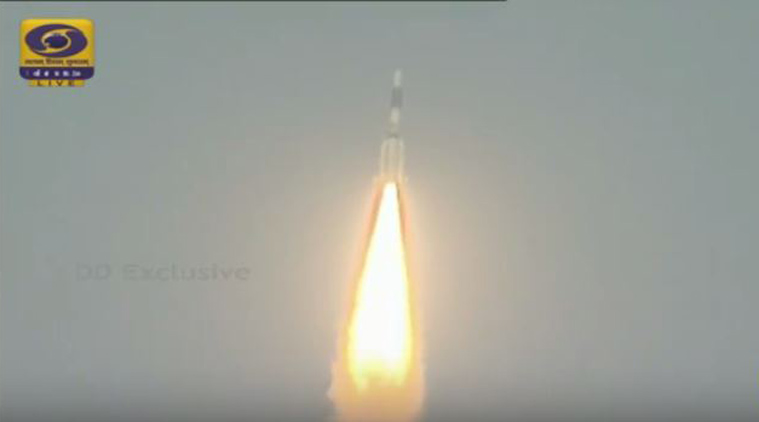- India
- International
GSLV satellite launch: Cryogenic success
GSAT-6 is the 25th communication satellite that India will put in the geostationary orbit and the 12th in the GSAT series.
 The 49.1 metre tall rocket weighing 416 tonnes would sling the 2,117 kg GSAT-6 communication satellite in the geosynchronous transfer orbit (GTO) around 17 minutes into the flight. (Source: Youtube)
The 49.1 metre tall rocket weighing 416 tonnes would sling the 2,117 kg GSAT-6 communication satellite in the geosynchronous transfer orbit (GTO) around 17 minutes into the flight. (Source: Youtube)
India’s space agency, ISRO, crossed another milestone, launching its first 2000-kg-plus satellite on Thursday afternoon on an indigenously built launch vehicle. The 2117-kg GSAT-6 communication satellite flew into space on GSLV-D6 launch vehicle from the Satish Dhawan Space Centre at Sriharikota.
The launch was significant not only for the heaviest satellite that has ever flown from Indian territory but also that it was only the second successful flight of the GSLV using an indigenous cryogenic engine– ISRO scientists have had a bitter-sweet experience with it till now.
GSLV, or Geosynchronous Satellite Launch Vehicle, is an advanced launch vehicle that can be used to carry satellites heavier than 2000-kg, even those weighing up to 5000-kg, into space. This is the vehicle that ISRO has been banking on to realise its future projects to explore deep space, far beyond even Mars where it has reached already.
GSLV’s higher capabilities, as compared to the PSLV or Polar Satellite Launch Vehicle that has made 28 successful launches in a row, is made possible by a the cryogenic part of the three-stage engine.
Cryogenics is the science of extremely low temperatures. The cryogenic engine uses the liquid engine and liquid hydrogen as propellants. Oxygen liquefies at -183-degree centigrade while hydrogen exists in liquid stage below -253 degree centigrade. The cryogenic engine is extremely efficient, providing greater thrust for every kilogram of propellant used as compared to solid or “earth-storable” liquid propellants. However, it is a highly complex system owing to the extremely low temperatures that need to be maintained.

The early successful flights of GSLV used Russian-made cryogenic engines. ISRO’s initial attempts to use its own cryogenic engine in the GSLV resulted in failure. It was only in January last year that the first GSLV with an indigenous cryogenic stage engine made a successful flight.
The GSAT-6 satellite that will beam communication signals from five slots in the S-band and one in the C-band for “strategic purposes” will be placed in the geostationary orbit. In this orbit, 36,000 km above the earth’s surface, a satellite appears stationary from any point in the earth because the time it takes to go around the orbit is the same as earth’s rotational period. Ground stations can remain permanently pointed to the satellites in this case and do not need to move to track them.
The launch vehicle will carry the GSAT-6 satellite till the geostationary transfer orbit (GTO) from where the satellite will use its own propellants to make its way to the geostationary orbit.
GSAT-6 is the 25th communication satellite that India will put in the geostationary orbit and the 12th in the GSAT series.
More Explained
EXPRESS OPINION
Apr 25: Latest News
- 01
- 02
- 03
- 04
- 05










































